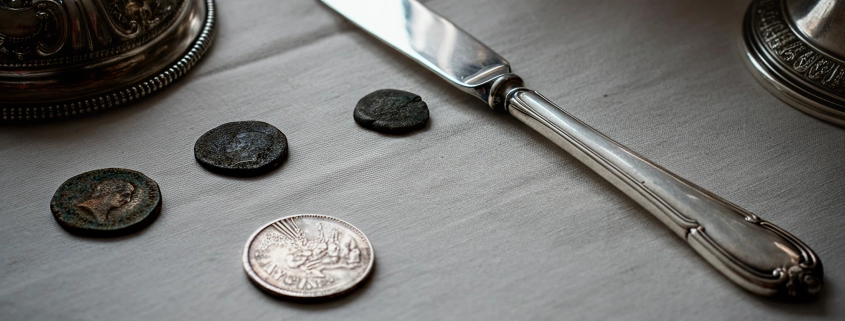When you hear the term sterling silver knives, it’s easy to assume that they are made entirely of pure silver. However, the truth is a bit more nuanced. Sterling silver knives, particularly butter knives, are not crafted from pure silver but rather sterling silver, an alloy of 92.5% silver and 7.5% other metals, typically copper. This distinction plays a significant role in the construction, durability, and value of these timeless flatware pieces.
This guide will help you understand the fascinating details behind sterling silver knives, how they are made, and how to distinguish between sterling silver, pure silver, and silver-plated flatware. By the end, you’ll have a greater appreciation for the craftsmanship behind these elegant dining tools.
RELATED: Sell your Sterling Silver to California Gold & Silver Exchange For Top Dollar
What Makes Sterling Silver Knives Different?
Sterling silver knives, including butter knives, are not made from pure silver for good reason. Pure silver, which contains 99.9% silver, is soft and malleable, making it unsuitable for everyday flatware. Sterling silver, on the other hand, is an alloy containing 92.5% silver and 7.5% copper, creating a balance between beauty and durability.
Key Features of Sterling Silver Knives
- Steel blades: Most sterling silver knives have blades made from stainless steel for sharpness and sturdiness.
- Sterling silver handles: The handles are crafted with an outer layer of authentic sterling silver (92.5% silver content) over a filler core, making them both beautiful and functional.
- Markings: Genuine sterling silver pieces are typically stamped with “Sterling” or “925,” signifying their authenticity as sterling silver.
The crucial thing to note is that while the handles are wrapped in genuine sterling silver, they are not solid sterling silver. Instead, a filler material is used inside the handle.
Understanding the Core of Sterling Silver Knife Handles
The construction of sterling silver knife handles is what often leads to confusion. While the outer layer is authentic sterling silver, the inside of the handle is filled with a core material rather than being a solid mass of silver.
Why Use a Filler Core Instead of Solid Silver?
- Cost-effectiveness: Using solid sterling silver for the entire handle would make it prohibitively expensive.
- Durability: A filler core adds stability to the handle, ensuring it can withstand regular use.
- Weight balance: The filler material provides the necessary heft for a comfortable grip and balanced handling.
What Materials Are Used as Fillers?
Filler materials can vary based on the age and manufacturer of the knife. Commonly used fillers include:
- Plaster
- Cement
- Epoxy resin
- Wax or lead (found in older vintage pieces)
These materials enhance the knife’s functionality while keeping the cost and weight manageable.
Sterling Silver Handles vs. Silver-Plated Handles
Not all silver-handled knives are created equal. Many people confuse sterling silver knives with silver-plated alternatives, but there are significant differences between the two.
| Feature | Sterling Silver Handle | Silver-Plated Handle |
|---|---|---|
| Outer Material | Solid sterling silver sheet | Thin silver plating over base metal |
| Core Material | Filler material (plaster, cement, etc.) | Base metal (e.g., nickel or brass) |
| Marking | “Sterling” or “925” | “Plated,” “EPNS,” or “Silverplate” |
| Value | Higher (due to real silver content) | Lower (minimal silver content) |
Sterling silver handles have a higher intrinsic value because of the actual silver content, whereas silver-plated items are more affordable but typically less durable and valuable.
How to Identify Your Sterling Silver Knife Handle
Wondering whether your knife handle is solid sterling silver, filled, or just silver-plated? Here are some tips to help you identify it:
- Check for markings: Look for engraved markings such as “Sterling” or “925.” Silver-plated pieces are usually marked with “EPNS” (Electroplated Nickel Silver) or similar terms.
- Perform a magnet test: Sterling silver is not magnetic, while base metals used in silver-plated items may attract a magnet.
- Tap test: Gently tap the handle against a hard surface. Sterling silver produces a soft, resonant tone, while plated items often sound dull.
- Seek professional appraisal: For vintage or unique pieces, a jeweler or antique expert can provide an accurate assessment.
By using these methods, you can identify whether your knife handle is genuine sterling silver or a less valuable alternative.
Are Vintage Knives More Likely to Be Solid Silver?
If you own vintage sterling silver knives, you might wonder if they are more likely to have solid sterling silver handles than modern ones. While vintage knives often feature higher quality craftsmanship, they rarely have handles made of solid sterling silver. Just like their modern counterparts, vintage sterling silver knives also typically use filler cores to balance cost and functionality.
However, the materials used for fillers in vintage pieces may differ. Older knives may contain wax or lead, materials less commonly used today due to safety concerns. This can make vintage knives more interesting to collectors but also requires additional care in handling and maintenance.
How Much Sterling Silver Is in a Knife Handle?
The amount of actual sterling silver in a knife handle depends on its construction:
- Sterling silver handle: The outer layer of a sterling silver handle is made from a thin sheet of sterling silver wrapped around the filler core.
- Silver-plated handle: Only a very thin layer of silver is applied, resulting in minimal silver content.
While sterling silver handles may not be solid silver, they still contain significantly more silver than silver-plated alternatives, giving them a higher value in terms of both aesthetics and material.
A Timeless Treasure for Your Dining Table
Sterling silver knives, particularly butter knives, are classic additions to any dining table. While they are not made from pure silver, their sterling silver construction combines durability, beauty, and practicality. Understanding their composition, from filler cores to authentic markings, provides valuable insights into their craftsmanship and value.
Whether you’re an avid collector or someone looking to invest in high-quality flatware, sterling silver knives are a testament to elegance and functionality. The next time you hold one in your hand, you’ll appreciate the care and detail that went into creating it.
Happy dining!
READ NEXT:







